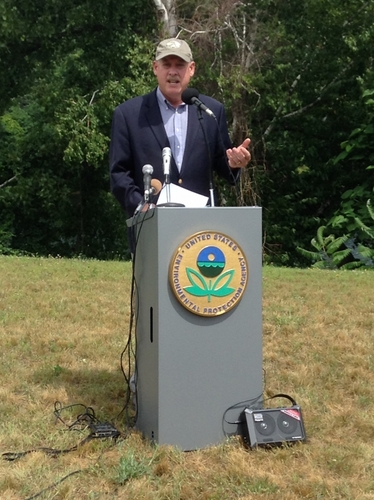BRATTLEBORO — As he opened a small ceremony to mark the awarding of federal brownfield funds to Vermont communities, Town Manager Peter Elwell stood on a lush green lawn bordering the Connecticut River.
The green space under Elwell's feet was once a brownfield, a contaminated area that can be expensive to clean and to rehabilitate for productive reuse.
Remnants of the town's industrial history still cling to its buildings, seen but not always noticed, such as the outlines of old loading bays in Main Street's sidewalks or the shape of side doors large enough to swallow vehicles.
But less-desirable elements of the town's former industry - elements such as asbestos, petroleum products, and chemicals - have also nestled deep within some buildings or the ground below them.
For a town like Brattleboro, with limited buildable land, abandoned buildings aren't only a blight. They can also mean missed economic opportunities.
To help decontaminate former industrial land, the federal Environmental Protection Agency (EPA) formally announced $2 million in Assessment Grants and Cleanup Grants to help Vermont communities tackle brownfields and support economic revitalization.
“We are grateful,” said Elwell during the official announcement.
Elwell added that Brattleboro's town government officials appreciated the state and federal assistance for cleaning up former industrial sites. He said the town's personnel has also appreciated learning from other communities tackling the same issues.
'A visible difference'
According to the EPA, these grants link objectives of protecting the environment and human health with economic development. Cleaning up the buildings removes toxins from the community while potentially putting disused buildings and land back to work and attracting jobs.
“EPA is proud to further assist Vermont and its citizens with this Brownfield funding. Cleaning and revitalizing contaminated sites helps create jobs and can be the catalyst to create new businesses or village centers, all while making our environment cleaner and the community healthier,” said H. Curtis “Curt” Spalding, regional administrator of the EPA's New England office.
Spalding said that the federal and state brownfields funds are often “the first dollars” to rehabilitate these difficult sites.
No one wants to spend the money on what can be a long and involved cleanup process, Spalding said.
“One thing we do is make a visible difference in communities,” Spalding said.
The EPA grants cover different aspects of mitigating brownfields such as an initial assessment of a contaminated area. Other funds pay for the physical cleanup.
He added that the brownfields grants were competitive. Spalding commended the talented people championing their Vermont communities.
Community reinvestment
• The town of Brattleboro received a $400,000 Brownfields Assessment Grant.
Planner Sue Fillion said that the town will use the funds to identify and invest in upcoming projects. Community members with potential brownfield projects can apply to the town.
• Brownfields Assessment grants of $400,000 also went to the Lamoille County Planning Commission, the Central Vermont Regional Planning Commission, and the Two-Rivers Ottauquechee Regional Commission.
• The Northwest Regional Planning Commission and Springfield Regional Development Corporation each received the Brownfields Cleanup Grant of $200,000.
EPA Brownfield Coordinator Frank Gardner said that this year, the EPA has $53 million to grant. The agency had $62 million last year.
According to a press release from the EPA, since the Brownfields program started in 2002, the EPA has awarded 334 assessment grants in New England totaling $97 million and 241 cleanup grants totaling $64.5 million.
Other funding has included 68 revolving loan fund grants and supplemental funding totaling $85.2 million.
The multiplier effect of these investments, writes the EPA, is $2.5 billion in public and private cleanup and redevelopment investment and more than 14,000 jobs.
“That completes the Santa Claus act of the day,” joked Spalding after distributing the large community check props. “It's such a terrific haul of money we've brought back to your community.”
On a serious note, Spalding added that the EPA considers how well a community will use its brownfields grants before awarding them. The agency looks for “good, strong local leadership,” and if other partners will invest in the projects.
“It's the prospects that drive this money,” he said.
Bellows Falls becomes part of BERA program
State officials also announced the three communities for inclusion into a state program called Brownfield Economic Revitalization Alliance (BERA) program. The program connects local, state, and federal agencies to help streamline the often convoluted process of redeveloping brownfields and abandoned buildings like factories.
Bellows Falls, Springfield, and Richmond joined the program this year.
The Rockingham Area Development Corporation will redevelop the former Robertson Paper Mill area in Bellows Falls as part of the BERA program. According to the presenters at the ceremony, the turn-of-the-century building on the Bellows Falls “island” will be demolished to make way for a new industrial space.
Springfield Regional Development Corporation will redevelop the former Jones and Lamson tooling facility. The building, which has been vacant for 30 years, will be transformed into a multi-use industrial and commercial space.
A developer is considering turning the former Saputo creamery in downtown Richmond into a mixed-use space including housing, commercial areas, and a senior center.
Projects in the BERA program move to the front of the line for some grant funding and a streamlined permitting process.
Revitalizing disused industrial sites is key to smart development, said Deputy Secretary of the Agency of Natural Resources Trey Martin, who said the state as a policy prefers redevelopment of disused areas inside towns rather than building new on previously undeveloped land.
Along with supporting the local economy by housing new businesses, keeping downtowns compact and encouraging people to live downtown helps reduce sprawl and protect the environment, Martin added.
But to entice people to live, work, shop, and walk in their downtowns requires that the downtowns are nice places to be, he said.
Vermont's BERA initiative is a collaboration of the Agency of Commerce and Community Development, Agency of Natural Resources, and Agency of Transportation.
“It's one of these feel-good public programs,” Martin said.
